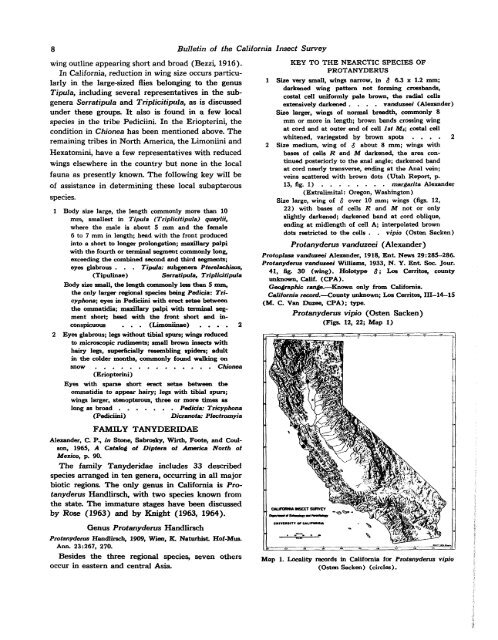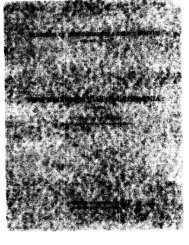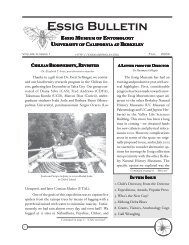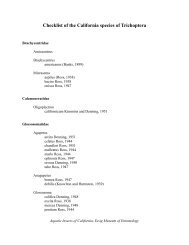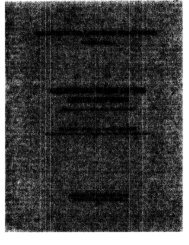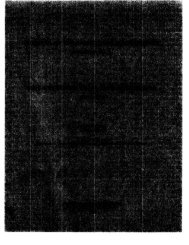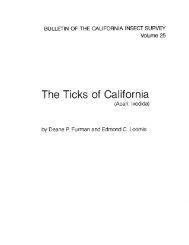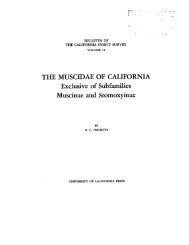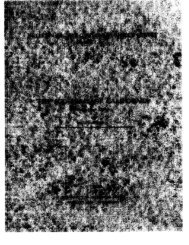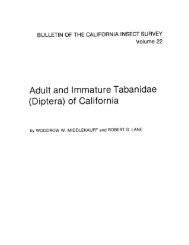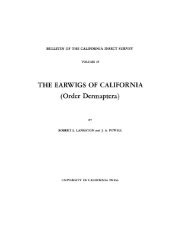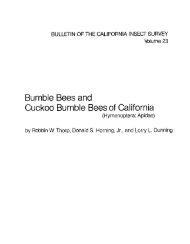The Crane Flies of California - Essig Museum of Entomology ...
The Crane Flies of California - Essig Museum of Entomology ...
The Crane Flies of California - Essig Museum of Entomology ...
You also want an ePaper? Increase the reach of your titles
YUMPU automatically turns print PDFs into web optimized ePapers that Google loves.
8 Bulletin <strong>of</strong> the <strong>California</strong> Insect Survey<br />
wing outline appearing short and broad (Bezzi, 1916).<br />
In <strong>California</strong>, reduction in wing size occurs particularly<br />
in the large-sized flies belonging to the genus<br />
TipuJa, including several representatives in the subgenera<br />
SerratipuJa and TripJicitipula, as is discussed<br />
under these groups. It also is found in a few local<br />
species in the tribe Pediciini. In the Eriopterini, the<br />
condition in Chionea has been mentioned above. <strong>The</strong><br />
remaining tribes in North America, the Limoniini and<br />
Hexatomini, have a few representatives with reduced<br />
wings elsewhere in the country but none in the local<br />
fauna as presently known. <strong>The</strong> following key wilI be<br />
<strong>of</strong> assistance in determining these local subapterous<br />
species.<br />
1 Body size large, the length commonly more than 10<br />
mm, smallest in Tipula (Triplicitipula) quaylii,<br />
where the male is about 5 mm and the female<br />
6 to 7 mm in length; head with the front produced<br />
into a short to longer prolongation; maxillary palpi<br />
with the fourth or terminal segment commonly long,<br />
exceeding the combined second and third segments;<br />
2<br />
eyes glabrous . . . Tipda: subgenera Pterelachisus,<br />
(Tipuliiae)<br />
Serratipula, Triplicitipula<br />
Body size small, the length commonly less than 5 mm,<br />
the only larger regional species being Pedicia: Tricyplrona;<br />
eyes in Pediciini with erect setae between<br />
the ommatidia; maxillary palpi with terminal segment<br />
short; head with the front short and inconspicuous<br />
. . . (Limoniinae) . . . . 2<br />
Eyes glabrous; legs without tibial spurs; wings reduced<br />
to microscopic rudlnants; small brown insects with<br />
hairy legs, superficially resembling spiders; adult<br />
in the colder months, commonly found walking on<br />
snow . . . . . . . . . . . . . . Chionea<br />
( Eriopterini )<br />
Eyes with sparse short erect setae between the<br />
ommatidia to appear hairy; legs with tibial spurs;<br />
wings larger, stenopterous, three or more times as<br />
long as broad . . . . . . . Pedicia: Tricyplrona<br />
(Pediciini)<br />
Dicranota. PIectmmyia<br />
FAMILY TANYDERIDAE<br />
Alexander, C. P.,in Stone, Sabrosky, Wid, Fmte, and Coulson,<br />
1965, A CataIog <strong>of</strong> Diptera <strong>of</strong> America North <strong>of</strong><br />
Mexico, p. 90.<br />
<strong>The</strong> family Tanyderidae includes 33 described<br />
species arranged in ten genera, occurring in all major<br />
biotic regions. <strong>The</strong> only genus in <strong>California</strong> is Protanyderus<br />
Handlirsch, with two species known from<br />
the state. <strong>The</strong> immature stages have been discussed<br />
by Rose (1963) and by Knight (1963, 1964).<br />
Genus Protanyderus Handlirsch<br />
Protanyderus Handlizsch, 1909, Wieu, K. Naturhist H<strong>of</strong>-Mus.<br />
Ann. 23:267, 270.<br />
Besides the three regional species, seven others<br />
occur in eastern and central Asia.<br />
KEY TO THE NEARCTIC SPECIES OF<br />
PROTANYDERUS<br />
1 Size very small, wings narrow, in 8 6.3 x 1.2 mm;<br />
darkened wing pattern not forming crossbands,<br />
costal cell uniformly pale brown, the radial cells<br />
extensively darkened . . . . vanduzeei (Alexander)<br />
Size larger, wings <strong>of</strong> normal breadth, comm~nly 8<br />
mm or more in length; brown bands crossing wing<br />
at cord and at outer end <strong>of</strong> cell 1st Mn; costal cell<br />
whitened, variegated by brown spots . . . . 2<br />
2 Size medium, wing <strong>of</strong> 8 about 8 mm; wings with<br />
bases <strong>of</strong> cells R and M darkened, the area continued<br />
posteriorly to the anal angle; darkened band<br />
at cord nearly transverse, ending at the Anal vein;<br />
veins scattered with brown dots (Utah Report, p.<br />
13, fig, 1) . . . . . . . . margarita Alexander<br />
(Extralimital: Oregon, Washington)<br />
Size large, wing <strong>of</strong> 8 over 10 mm; wings (figs. 12,<br />
22) with bases <strong>of</strong> cells R and M not or only<br />
slightly darkened; darkened band at cord oblique,<br />
ending at midlength <strong>of</strong> cell A; interpolated brown<br />
dots restricted to the cells . . vipio (Osten Sacken)<br />
Protanyderus vanduzeei (Alexander)<br />
Protoplasa vanduze& Alexander, 1918, Ent News 29:285-286.<br />
Protanydems vanduzeei Williams, 1933, N. Y. Ent. Soc. Jour.<br />
41, fig. 30 (wing). Holotype 8; Los Cerritos, county<br />
unknown, Cali. (CPA).<br />
Geographic range.-Knm only from <strong>California</strong>.<br />
Califom*ia zecord.--County unknown; Lw Cerritos, III-14-15<br />
(M. C. Van bee, CPA); type.<br />
Protanyderus vipio (Osten Sacken)<br />
(Figs. 12, 22; Map 1)<br />
Map 1. Locality records in <strong>California</strong> for Protanyderus vipio<br />
(Osten Sacken) (circles).


